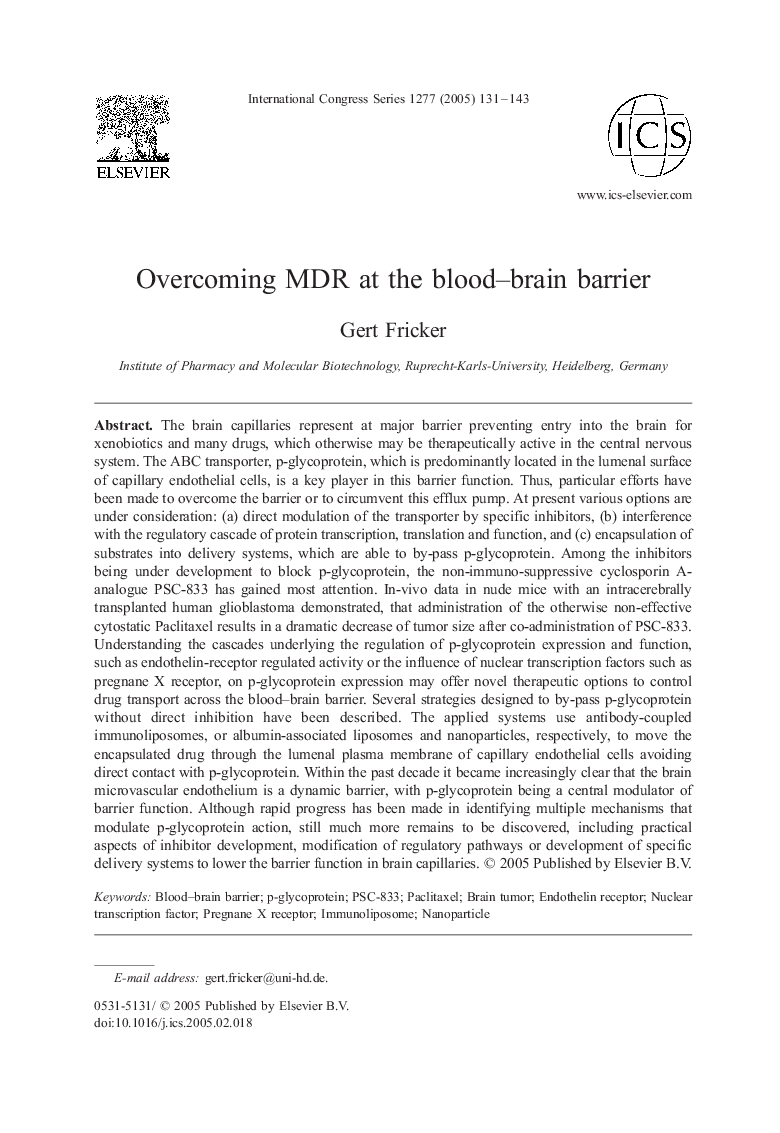| کد مقاله | کد نشریه | سال انتشار | مقاله انگلیسی | نسخه تمام متن |
|---|---|---|---|---|
| 9022184 | 1561380 | 2005 | 13 صفحه PDF | دانلود رایگان |
عنوان انگلیسی مقاله ISI
Overcoming MDR at the blood-brain barrier
دانلود مقاله + سفارش ترجمه
دانلود مقاله ISI انگلیسی
رایگان برای ایرانیان
کلمات کلیدی
PSC-833P-glycoprotein - P-گلیکوپروتئینImmunoliposome - ایمونولایپوزومBrain tumor - تومور مغزیBlood–brain barrier - سد خونی مغزیNuclear transcription factor - فاکتور رونویسی هسته ایNanoparticle - نانوذارتPaclitaxel - پاکلی تاکسلEndothelin receptor - گیرنده اندوتلینPregnane X receptor - گیرنده پیش گران X
موضوعات مرتبط
علوم زیستی و بیوفناوری
بیوشیمی، ژنتیک و زیست شناسی مولکولی
زیست شناسی مولکولی
پیش نمایش صفحه اول مقاله

چکیده انگلیسی
The brain capillaries represent at major barrier preventing entry into the brain for xenobiotics and many drugs, which otherwise may be therapeutically active in the central nervous system. The ABC transporter, p-glycoprotein, which is predominantly located in the lumenal surface of capillary endothelial cells, is a key player in this barrier function. Thus, particular efforts have been made to overcome the barrier or to circumvent this efflux pump. At present various options are under consideration: (a) direct modulation of the transporter by specific inhibitors, (b) interference with the regulatory cascade of protein transcription, translation and function, and (c) encapsulation of substrates into delivery systems, which are able to by-pass p-glycoprotein. Among the inhibitors being under development to block p-glycoprotein, the non-immuno-suppressive cyclosporin A-analogue PSC-833 has gained most attention. In-vivo data in nude mice with an intracerebrally transplanted human glioblastoma demonstrated, that administration of the otherwise non-effective cytostatic Paclitaxel results in a dramatic decrease of tumor size after co-administration of PSC-833. Understanding the cascades underlying the regulation of p-glycoprotein expression and function, such as endothelin-receptor regulated activity or the influence of nuclear transcription factors such as pregnane X receptor, on p-glycoprotein expression may offer novel therapeutic options to control drug transport across the blood-brain barrier. Several strategies designed to by-pass p-glycoprotein without direct inhibition have been described. The applied systems use antibody-coupled immunoliposomes, or albumin-associated liposomes and nanoparticles, respectively, to move the encapsulated drug through the lumenal plasma membrane of capillary endothelial cells avoiding direct contact with p-glycoprotein. Within the past decade it became increasingly clear that the brain microvascular endothelium is a dynamic barrier, with p-glycoprotein being a central modulator of barrier function. Although rapid progress has been made in identifying multiple mechanisms that modulate p-glycoprotein action, still much more remains to be discovered, including practical aspects of inhibitor development, modification of regulatory pathways or development of specific delivery systems to lower the barrier function in brain capillaries.
ناشر
Database: Elsevier - ScienceDirect (ساینس دایرکت)
Journal: International Congress Series - Volume 1277, April 2005, Pages 131-143
Journal: International Congress Series - Volume 1277, April 2005, Pages 131-143
نویسندگان
Gert Fricker,